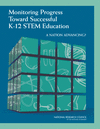by Mark K. Fiegener and Steven L. Proudfoot[1]
Foreign institutions and U.S. research universities play large roles in the baccalaureate education of U.S.-trained science and engineering (S&E) doctorate recipients.[2] In 2011, about one-third (35%) of individuals earning S&E doctorates from U.S. universities held bachelor's degrees from foreign institutions, and 29% earned bachelor's degrees from U.S. doctorate-granting institutions with very high research activity[3] (table 1). Other doctorate-granting universities, master's colleges and universities, and baccalaureate colleges combined to account for another 28%. Among U.S. S&E doctorate recipients, the proportion with a foreign bachelor's degree increased 4 percentage points from 2002 to 2011, while the proportion with a bachelor's degree from a U.S. institution declined slightly over this period for each type of institution.
http://www.nsf.gov/statistics/infbrief/nsf13323/ |

 "Following a 2011 report by the National Research Council (NRC) on successful K-12 education in science, technology, engineering, and mathematics (STEM), Congress asked the National Science Foundation to identify methods for tracking progress toward the report's recommendations. In response, the NRC convened the Committee on an Evaluation Framework for Successful K-12 STEM Education to take on this assignment. The committee developed 14 indicators linked to the 2011 report's recommendations. By providing a focused set of key indicators related to students' access to quality learning, educator's capacity, and policy and funding initiatives in STEM, the committee addresses the need for research and data that can be used to monitor progress in K-12 STEM education and make informed decisions about improving it.
"Following a 2011 report by the National Research Council (NRC) on successful K-12 education in science, technology, engineering, and mathematics (STEM), Congress asked the National Science Foundation to identify methods for tracking progress toward the report's recommendations. In response, the NRC convened the Committee on an Evaluation Framework for Successful K-12 STEM Education to take on this assignment. The committee developed 14 indicators linked to the 2011 report's recommendations. By providing a focused set of key indicators related to students' access to quality learning, educator's capacity, and policy and funding initiatives in STEM, the committee addresses the need for research and data that can be used to monitor progress in K-12 STEM education and make informed decisions about improving it.